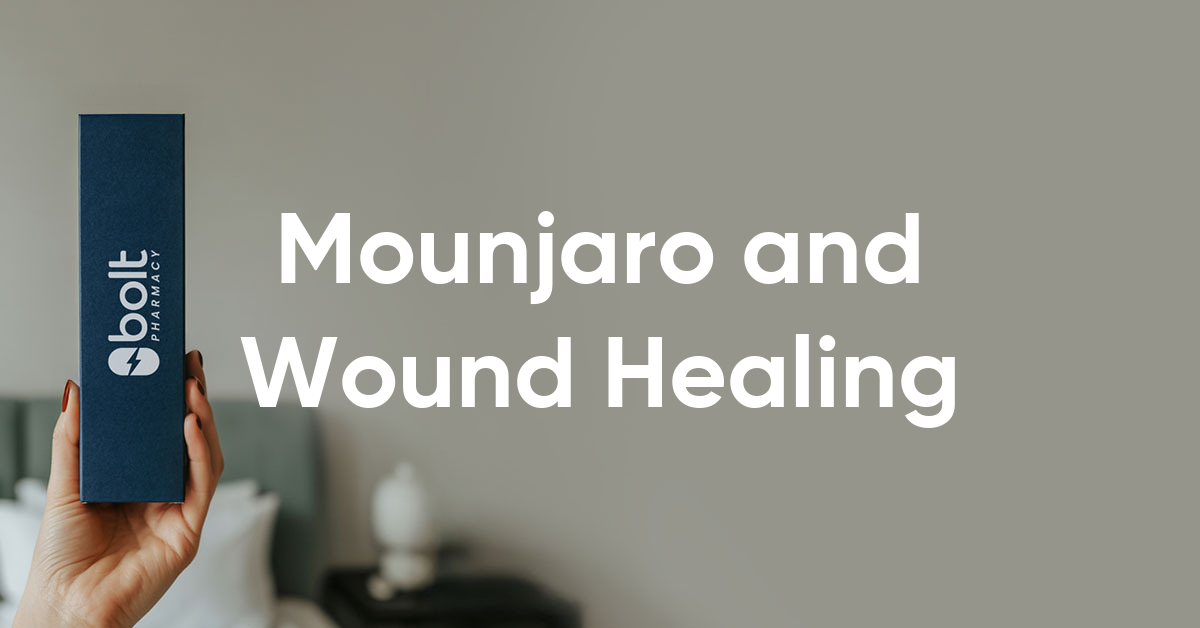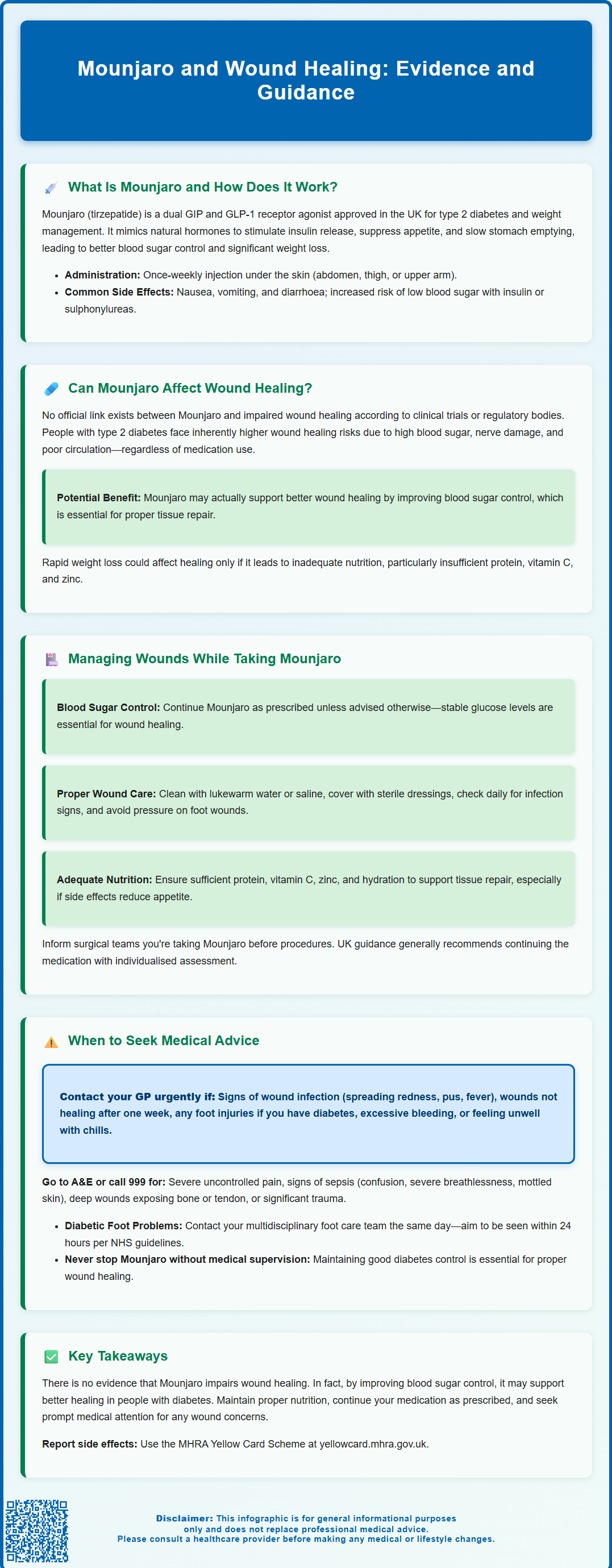Mounjaro®
Dual-agonist support that helps curb appetite, hunger, and cravings to drive substantial, sustained weight loss.
- ~22.5% average body weight loss
- Significant weight reduction
- Improves blood sugar levels
- Clinically proven weight loss

Mounjaro (tirzepatide) is a dual GIP and GLP-1 receptor agonist licensed in the UK for type 2 diabetes and weight management. As with any medication affecting metabolic processes, patients may wonder about potential effects on wound healing. Whilst there is no established evidence that Mounjaro directly impairs wound healing, understanding the relationship between diabetes control, nutrition, and tissue repair is important for anyone taking this medication. This article examines current evidence on Mounjaro and wound healing, practical wound care guidance, and when to seek medical advice.
Summary: There is no established evidence that Mounjaro (tirzepatide) directly impairs wound healing, and it is not listed as a recognised adverse effect by UK regulatory bodies.
Mounjaro (tirzepatide) is a prescription medicine licensed in the UK for the treatment of type 2 diabetes mellitus and, more recently, for weight management in adults with obesity (BMI ≥30 kg/m²) or overweight (BMI ≥27 kg/m²) with weight-related comorbidities, as an adjunct to reduced-calorie diet and increased physical activity. It belongs to a novel class of medications known as dual glucose-dependent insulinotropic polypeptide (GIP) and glucagon-like peptide-1 (GLP-1) receptor agonists. This dual mechanism distinguishes Mounjaro from other GLP-1 receptor agonists currently available.
The medication works by mimicking the action of two naturally occurring incretin hormones in the body. GLP-1 stimulates insulin secretion when blood glucose levels are elevated, suppresses glucagon release (which normally raises blood sugar), slows gastric emptying, and reduces appetite through effects on the central nervous system. GIP also enhances insulin secretion and may have additional effects on fat metabolism and energy balance. Together, these actions help improve glycaemic control in people with type 2 diabetes and promote significant weight loss.
Mounjaro is administered as a once-weekly subcutaneous injection, typically in the abdomen, thigh, or upper arm. The dose is gradually increased over several weeks to minimise gastrointestinal side effects such as nausea, vomiting, and diarrhoea, which are among the most commonly reported adverse reactions. When used with insulin or sulfonylureas, there is an increased risk of hypoglycaemia. The Medicines and Healthcare products Regulatory Agency (MHRA) has approved Mounjaro for use in the UK, and the National Institute for Health and Care Excellence (NICE) provides specific guidance on its use within the NHS for eligible patients.
As with any medication that affects metabolic processes, patients and healthcare professionals may have questions about potential effects on other bodily functions, including tissue repair and wound healing. Understanding how Mounjaro works helps contextualise any concerns about its broader physiological impacts.
Patients should report any suspected side effects to the MHRA Yellow Card Scheme (yellowcard.mhra.gov.uk).

Currently, there is no official established link between Mounjaro (tirzepatide) and impaired wound healing based on clinical trial data and post-marketing surveillance. The medication's UK Summary of Product Characteristics (SmPC) does not list delayed wound healing as a recognised adverse effect, and regulatory bodies such as the MHRA and the European Medicines Agency (EMA) have not issued specific warnings regarding wound healing complications associated with tirzepatide use.
However, it is important to consider the broader context of diabetes management and wound healing. People with type 2 diabetes are inherently at higher risk of wound healing complications due to several factors, including:
Hyperglycaemia: Elevated blood glucose levels can impair immune function, reduce collagen synthesis, and compromise microvascular circulation, all of which are essential for normal wound healing.
Peripheral neuropathy: Reduced sensation may lead to unnoticed injuries, particularly on the feet.
Peripheral arterial disease: Compromised blood flow limits oxygen and nutrient delivery to healing tissues.
Immune dysfunction: Diabetes can affect white blood cell function, increasing infection risk.
By improving glycaemic control, Mounjaro may theoretically support better wound healing in people with diabetes, as maintaining blood glucose within target ranges is a cornerstone of wound management. Some research on GLP-1 receptor agonists has suggested potential beneficial effects on endothelial function and inflammation, which could indirectly support tissue repair, though specific clinical evidence for tirzepatide's effects on wound healing remains limited and mixed.
Rapid weight loss associated with Mounjaro treatment could theoretically affect nutritional status if dietary intake becomes inadequate. Protein, vitamins (particularly vitamin C), and minerals such as zinc are crucial for wound healing. While vitamin A also plays a role in wound healing, high-dose supplementation is not routinely recommended unless deficiency is confirmed. Patients experiencing significant weight loss should ensure they maintain adequate nutrition to support tissue repair processes. There is no evidence, however, that the weight loss achieved with Mounjaro directly impairs wound healing when nutrition remains adequate.
If you develop a wound whilst taking Mounjaro, proper wound care principles remain the same as for any individual, with particular attention to factors relevant to diabetes management. Good glycaemic control is paramount—continue taking Mounjaro as prescribed unless specifically advised otherwise by your healthcare provider, as maintaining stable blood glucose levels supports optimal healing.
Basic wound care measures include:
Cleansing: Gently clean wounds with lukewarm water or saline solution. Avoid harsh antiseptics that may damage healing tissue.
Protection: Cover wounds with appropriate sterile dressings to maintain a moist healing environment and prevent infection.
Monitoring: Check wounds daily for signs of infection (increased redness, warmth, swelling, purulent discharge, or worsening pain).
Pressure relief: For foot wounds, avoid weight-bearing on the affected area and consider specialised footwear or offloading devices as recommended.
Nutritional considerations are particularly important during wound healing. Ensure adequate intake of:
Protein: Essential for collagen formation and tissue repair. Consider discussing personalised targets with a dietitian, particularly if you have chronic kidney disease.
Vitamin C: Supports collagen synthesis and immune function.
Zinc: Plays a role in protein synthesis and cell proliferation.
Adequate hydration: Supports cellular function and nutrient transport.
If Mounjaro is causing persistent nausea or reduced appetite that limits your nutritional intake, discuss this with your GP or diabetes specialist nurse. They may suggest strategies to manage side effects or temporarily adjust your dose. Never stop Mounjaro without medical guidance, as abrupt discontinuation could lead to deterioration in glycaemic control.
For surgical wounds or planned procedures, inform your surgical team that you are taking Mounjaro. UK Centre for Perioperative Care (CPOC) guidance generally suggests continuing GLP-1 receptor agonists before elective surgery, with individualised assessment based on aspiration risk and gastrointestinal symptoms. Follow your local hospital's policy and your healthcare team's specific advice.
Importantly, any suspected diabetic foot ulcer or infection requires same-day contact with healthcare services and assessment by the multidisciplinary foot care team.
Prompt medical attention is essential if you experience any concerning signs related to wound healing whilst taking Mounjaro. Contact your GP or diabetes care team urgently if you notice:
Signs of infection: Increasing redness spreading beyond the wound edges, warmth, swelling, pus or cloudy discharge, red streaks extending from the wound, or fever.
Non-healing wounds: Any wound that shows no signs of improvement after one week of appropriate care, or that appears to be worsening.
Diabetic foot problems: Any injury, blister, cut, or area of redness on your feet, particularly if you have reduced sensation due to neuropathy.
Unusual bleeding or bruising: Wounds that bleed excessively or bruising that appears without obvious cause.
Systemic symptoms: Feeling generally unwell, experiencing chills, or developing a high temperature alongside a wound.
Seek immediate medical attention (attend A&E or call 999) if you develop:
Severe pain that is not controlled by over-the-counter analgesia
Signs of sepsis (confusion, severe breathlessness, mottled or very pale skin, feeling extremely unwell)
A deep wound with visible bone, tendon, or foreign material
Significant trauma or wounds from contaminated sources
For people with diabetes, the NHS provides specialist multidisciplinary foot care services. If you have an active diabetic foot problem (ulceration, infection, or ischaemia), NICE guidelines recommend same-day contact and assessment by the multidisciplinary foot care team, with the aim to be seen within 24 hours. For high-risk feet without active disease, referral to the foot protection service within 2-4 working days is recommended. Lower-risk concerns should follow local care pathways.
If you have concerns about whether Mounjaro might be affecting your wound healing, discuss this openly with your healthcare provider. They can assess your individual circumstances, review your glycaemic control, evaluate nutritional status, and determine whether any adjustments to your treatment plan are necessary. Do not discontinue Mounjaro without medical supervision, as maintaining good diabetes control remains fundamental to supporting wound healing.
There is no established evidence that Mounjaro (tirzepatide) directly impairs wound healing. By improving glycaemic control, it may actually support better healing in people with diabetes, though specific clinical evidence remains limited.
No, you should not stop Mounjaro without medical supervision. Maintaining good glycaemic control is essential for wound healing, so continue taking your medication as prescribed unless your healthcare provider advises otherwise.
Contact your GP or diabetes care team urgently if you notice signs of infection, non-healing wounds after one week, any foot injury (particularly with neuropathy), or systemic symptoms such as fever. Diabetic foot problems require same-day assessment by the multidisciplinary foot care team.
The health-related content published on this site is based on credible scientific sources and is periodically reviewed to ensure accuracy and relevance. Although we aim to reflect the most current medical knowledge, the material is meant for general education and awareness only.
The information on this site is not a substitute for professional medical advice. For any health concerns, please speak with a qualified medical professional. By using this information, you acknowledge responsibility for any decisions made and understand we are not liable for any consequences that may result.
Lorem ipsum dolor sit amet, consectetur adipiscing elit, sed do eiusmod tempor incididunt ut labore et dolore magna aliqua. Ut enim ad minim veniam, quis nostrud exercitation ullamco laboris nisi ut aliquip ex ea commodo consequat. Duis aute irure dolor in reprehenderit in voluptate velit esse cillum dolore eu fugiat nulla pariatur.
Block quote
Ordered list
Unordered list
Bold text
Emphasis
Superscript
Subscript